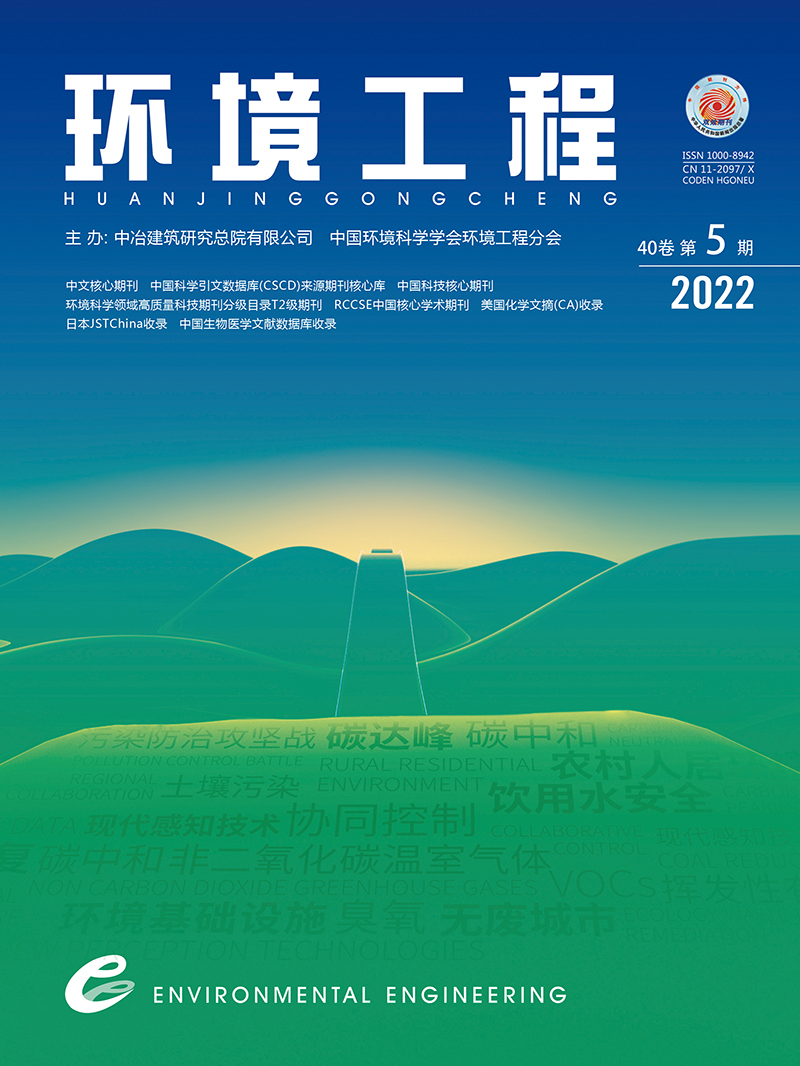| [1] |
MA D S,YI H,LAI C,et al.Critical review of advanced oxidation processes in organic wastewater treatment[J].Chemosphere,2021,275:130104.
|
| [2] |
GIANNAKIS S,LIN K Y A,GHANBARI F.A review of the recent advances on the treatment of industrial wastewaters by sulfate radical-based advanced oxidation processes (SR-AOPs)[J].Chemical Engineering Journal,2021,406:127083.
|
| [3] |
TU X,MENG X Y,PAN Y,et al.Degradation kinetics of target compounds and correlations with spectral indices during UV/H2O2 post-treatment of biologically treated acrylonitrile wastewater[J].Chemosphere,2020,243:125384.
|
| [4] |
OYEKUNLE D T,CAI J,GENDY E A,et al.Impact of chloride ions on activated persulfates based advanced oxidation process (AOPs):a mini review[J].Chemosphere,2021,280:130949.
|
| [5] |
XIE Y W,XU R Y,LIU R,et al.Adsorbable organic halogens formed during treatment of Cl--containing wastewater by sulfate and hydroxyl radical-based advanced oxidation processes[J].Chemical Engineering Journal,2020,389:124457.
|
| [6] |
HU L M,ZHANG G S,LIU M,et al.Enhanced degradation of Bisphenol A (BPA) by peroxymonosulfate with Co3O4-Bi2O3 catalyst activation:effects of pH,inorganic anions,and water matrix[J].Chemical Engineering Journal,2018,338:300-310.
|
| [7] |
WANG Y B,CAO D,ZHAO X.Heterogeneous degradation of refractory pollutants by peroxymonosulfate activated by CoOx-doped ordered mesoporous carbon[J].Chemical Engineering Journal,2017,328:1112-1121.
|
| [8] |
ANIPSITAKIS G P,DIONYSIOU D D,GONZALEZ M A.Cobalt-mediated activation of peroxymonosulfate and sulfate radical attack on phenolic compounds:implications of chloride ions[J].Environmental Science& Technology,2006,40(3):1000-1007.
|
| [9] |
YUAN R,RAMJAUN S N,WANG Z,et al.Photocatalytic degradation and chlorination of azo dye in saline wastewater:Kinetics and AOX formation[J].Chemical Engineering Journal,2012,192:171-178.
|
| [10] |
FANG C L,XIAO D X,LIU W Q,et al.Enhanced AOX accumulation and aquatic toxicity during 2,4,6-trichlorophenol degradation in a Co (Ⅱ)/peroxymonosulfate/Cl- system[J].Chemosphere,2016,144:2415-2420.
|
| [11] |
KACZMARCZYK A,NIEMIRYCZ E.Adsorbable organic halogens (AOX) in polish rivers-levels and changes[J].Acta Hydrochimica et Hydrobiologica,2005,33(4):324-336.
|
| [12] |
XU R Y,XIE Y W,TIAN J P,et al.Adsorbable organic halogens in contaminated water environment:a review of sources and removal technologies[J].Journal of Cleaner Production,2021,283:124645.
|
| [13] |
YANG W C,LI X M,XI D D,et al.Synergistic chromium (Ⅵ) reduction and phenol oxidative degradation by FeS2/Fe0 and persulfate[J].Chemosphere,2021,281:130957.
|
| [14] |
任龙飞,徐宇博,邵嘉慧.新型PDMS相转化膜在萃取膜生物反应器中的应用[J].环境工程,2021,39(7):133-138.
|
| [15] |
XIE Y W,CHEN L J,LIU R,et al.AOX contamination in Hangzhou Bay,China:Levels,distribution and point sources[J].Environmental Pollution,2018,235:462-469.
|
| [16] |
OLMEZ-HANCI T,ARSLAN-ALATON I.Comparison of sulfate and hydroxyl radical based advanced oxidation of phenol[J].Chemical Engineering Journal,2013,224:10-16.
|
| [17] |
ESPLUGAS S,GIMENEZ J,CONTRERAS S,et al.Comparison of different advanced oxidation processes for phenol degradation[J].Water Research,2002,36(4):1034-1042.
|
| [18] |
GREBEL J E,PIGNATELLO J J,MITCH W A.Effect of halide ions and carbonates on organic contaminant degradation by hydroxyl radical-based advanced oxidation processes in saline waters[J].Environmental Science& Technology,2010,44(17):6822-6828.
|
| [19] |
STEFAN M I,HOY A R,BOLTON J R.Kinetics and mechanism of the degradation and mineralization of acetone in dilute aqueous solution sensitized by the UV photolysis of hydrogen peroxide[J].Environmental Science& Technology,1996,30(7):2382-2390.
|
| [20] |
LEE Y M,LEE G,ZOH K D.Benzophenone-3 degradation via UV/H2O2 and UV/persulfate reactions[J].Journal of Hazardous Materials,2021,403:123591.
|
| [21] |
HUANG Y F,HUANG Y H.Identification of produced powerful radicals involved in the mineralization of bisphenol A using a novel UV-Na2S2O8/H2O2-Fe (Ⅱ,Ⅲ) two-stage oxidation process[J].Journal of Hazardous Materials,2009,162(2/3):1211-1216.
|
| [22] |
LIU J,LIU Y,TIAN Y,et al.Comparison of the oxidation of halogenated phenols in UV/PDS and UV/H2O2 advanced oxidation processes[J].RSC Advances,2020,10(11):6464-6472.
|
| [23] |
LUTZE H V,KERLIN N,SCHMIDT T C.Sulfate radical-based water treatment in presence of chloride:formation of chlorate,inter-conversion of sulfate radicals into hydroxyl radicals and influence of bicarbonate[J].Water Research,2015,72:349-360.
|
| [24] |
YANG Y,PIGNATELLO J J,MA J,et al.Comparison of halide impacts on the efficiency of contaminant degradation by sulfate and hydroxyl radical-based advanced oxidation processes (AOPs)[J].Environmental Science& Technology,2014,48(4):2344-2351.
|
| [25] |
WANG Z H,YUAN R X,GUO Y G,et al.Effects of chloride ions on bleaching of azo dyes by Co2+/oxone regent:kinetic analysis[J].Journal of Hazardous Materials,2011,190(1/2/3):1083-1087.
|
| [26] |
WANG F G,WANG W J,YUAN S J,et al.Comparison of UV/H2O2 and UV/PS processes for the degradation of thiamphenicol in aqueous solution[J].Journal of Photochemistry and Photobiology a-Chemistry,2017,348:79-88.
|
| [27] |
GHALY M Y,HARTEL G,MAYER R,et al.Photochemical oxidation of p-chlorophenol by UV/H2O2 and photo-Fenton process:a comparative study[J].Waste Management,2001,21(1):41-47.
|
| [28] |
PEIRO A M,AYLLON J A,PERAL J,et al.TIO2-photocatalyzed degradation of phenol and ortho-substituted phenolic compounds[J].Applied Catalysis B-Environmental,2001,30(3/4):359-373.
|
| [29] |
FANG J Y,FU Y,SHANG C.The roles of reactive species in micropollutant degradation in the UV/free chlorine system[J].Environmental Science& Technology,2014,48(3):1859-1868.
|
| [30] |
IANNI J C.Kintecus,Windows version V6.51[Z].2018;Available from:http://kintecus.com/.
|
| [31] |
BAYCAN N,THOMANETZ E,SENGUL F.Influence of chloride concentration on the formation of AOX in UV oxidative system[J].Journal of Hazardous Materials,2007,143(1/2):171-176.
|
| [32] |
MINISCI F,CITTERIO A,GIORDANO C.Electron-transfer processes-peroxydisulfate,a useful and versatile reagent in organic-chemistry[J].Accounts of Chemical Research,1983,16(1):27-32.
|
| [33] |
李卫平,郝梦影,敬双怡,等.SMBBR处理焦化废水性能及菌群结构响应关系[J].中国环境科学,2019,39(8):3332-3339.
|
| [34] |
LU J H,BENJAMIN M M,KORSHIN G V,et al.Reactions of the flavonoid hesperetin with chlorine:a spectroscopic study of the reaction pathways[J].Environmental Science& Technology,2004,38(17):4603-4611.
|


 Login
Login Register
Register E-alert
E-alert






 DownLoad:
DownLoad: